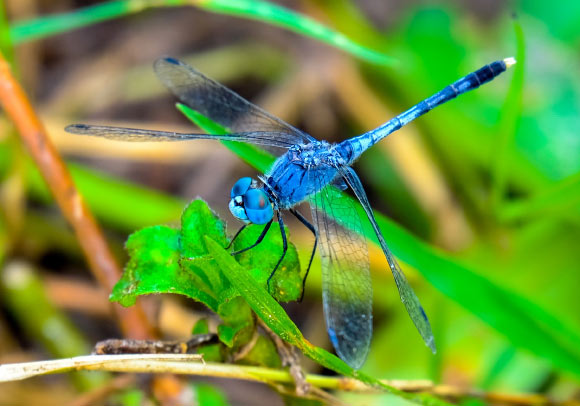According to new research published in the journal eLife, the dragonfly brain can perform visual tasks that were previously associated only with mammals.

Wiederman et al have shown how a dragonfly’s brain anticipates the movement of its prey. Image credit: Komkrich Srigoson.
“Until now, scientists have primarily considered the capabilities of mammals, such as humans, for investigating how animals can predict where a moving object will be in the near future,” said lead author Dr. Steven Wiederman, from the University of Adelaide.
“Understandably, mammals in many ways are more complex organisms than insects, but with each discovery we’re finding that dragonflies have keen visual and neural processes that could be ideal for translating into technological advances.”
Dr. Wiederman and co-authors were able to record specific target-detecting neurons, called Small Target Motion Detector (STMD) neurons, in the brain of the tau emerald (Hemicordulia tau), a species of dragonfly found in Australia.
These neurons make it possible to focus on a small object that moves over a complex background, similarly to how humans can track and catch a ball, even when that ball is moving against the backdrop of a cheering crowd.
The dragonfly STMD neurons can make a selection of a single target from the mass of visual information that the brain receives, such as the motion of another insect, and then predict its direction and future location,”
“The dragonfly, like humans, makes this assessment based on the path along which the object moves,” said senior author Professor David O’Carroll, of Lund University.
“In other words, the dragonfly does something very similar to what we do when we track a ball in motion. Despite major differences in the complexity of the brain, evolution has led to the insect using its brain for advanced visual processes that are usually only considered in mammals.”
The STMD neurons increased their responses in a small ‘focus’ area just in front of the location of a moving object being tracked.
If the object then disappeared from the field of vision, the focus spread forward over time, allowing the brain to predict where the target was most likely to reappear.
The neuronal prediction was based on the previous path along which the prey had flown.
“Insects and mammals last shared a common ancestor more than 500 million years ago, and, in many respects, mammalian brains are substantially more complex than insect brains,” the authors said.
“Nevertheless, the new results show that the insect brain can perform visual tasks that were previously associated only with mammals.”
“Neuroscientists and engineers have used the insect brain for decades to study the circuits that support biological processes.”
“In the coming years, insects such as the dragonfly may enable us to explore how visual regions of the brain predict future events. This knowledge could ultimately be applied to artificial vision systems, such as those in self-driving cars.”
_____
Steven D. Wiederman et al. 2017. A predictive focus of gain modulation encodes target trajectories in insect vision. eLife 6: e26478; doi: 10.7554/eLife.26478







